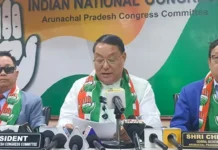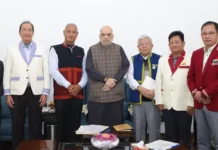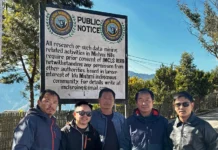[ Junroi Mamai ]
LONGDING, 10 Dec: With the approach of winter, Longding district is once again hit with acute water crisis as rains start to dwindle and perennial sources of water start to dry up.
The district has been facing shortage of water for many years, especially during the dry winter months. Currently, people in the district are getting reduced water supply due to water rationing as the water sources have drastically reduced and the main distribution network from the Wakka project in Longding is undergoing major repair.
Longding PHED Division EE Tage Nipa informed The Arunachal Times that the main water supply pipeline from Wakka, (around 32 kms from Longding town) suffered severe damage owing to heavy rainfall-triggered landslides. “Around 22 kms length of the pipeline was damaged; it is also located in an inaccessible area. Until August, the department workers could not enter the area, but somehow we managed to start restoration work in October. We will be able to complete the restoration work within this week,” the EE informed.
Longding district has four local water sources to cater to the demands of the township’s growing population.
Nipa informed that the daily requirement of Longding township is around 6 to 7 lakhs litres of water, which is sufficiently fulfilled during monsoon as these four water sources receive plenty of rain, but the situation drastically changes during the winter months. During winters, the water supply dwindles to about 2 lakhs litres per day, which leads to poor water supply.
“Areas near the higher secondary school and the DC bungalow are the worst affected,” he said, adding that local sources of water cannot fulfil the demands anymore.
Longding Deputy Commissioner Bekir Nyorak pointed out issues like jhum cultivation and less perennial sources of water as the main causes of water crisis in the district.
“Longding is a rain-fed district. Due to extensive jhumming, forests are cleared for cultivation near water catchment areas,” he said. He, however, also acknowledged the fact that the hilly and hostile terrain of Longding does not allow locals to take up wet rice cultivation and give up jhum cultivation completely.
“We have therefore, time and again, stressed the need for cash crop cultivation for the sustainability of the people in the long run,” the DC added.
Terming awareness campaigns among villagers about the adverse impacts of jhum cultivation vital to address the water crisis, Nipa said, “The department of PHE and the district administration have been jointly carrying out information, education, and communication (IEC) campaigns over the last three years on the issue and we have through persistent efforts witnessed that some villages, like Chanu, Ranglua, Russa, Kaimai and Ozakho, have started to adopt water conservation efforts.”
The villages of Chanu, Ranglua, Russa, Kaimai and Ozakho have now started to take up plantation drives at water catchment areas and are avoiding jhum cultivation. People of these villages also construct recharging pits which collect rainwater and recharge ground water also.
“People in Kaimai village have also come up with a new arrangement of sharing land, wherein those who have large cultivable land share it with other villagers, especially those whose land is close to water catchment areas. This ensures that the forests near water catchment areas are not disturbed. Though only four or five villages of the total 76 villages of the district have adopted these conservation efforts, it is nonetheless a positive outcome of our continuous efforts. We need more villages to adopt similar arrangements and conservation efforts to mitigate the issue of water scarcity in the district,” he said.





